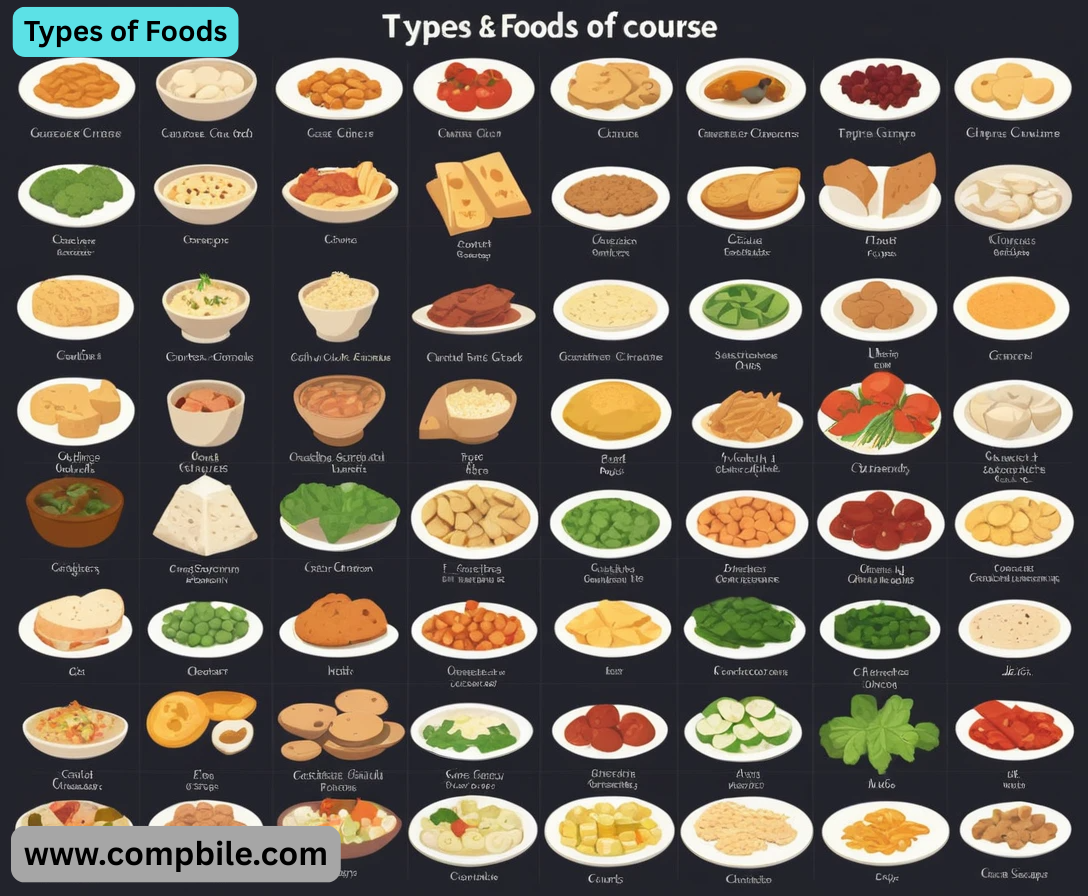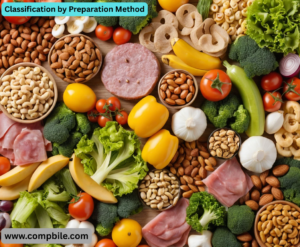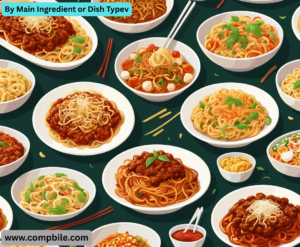Types of Foods Of course! Here is a comprehensive guide to the different types of foods, categorized in various ways to help you understand the vast world of cuisine. Foods can be classified by their nutritional role, their origin, how they are prepared, and the cuisine they belong to.
Classification by Nutritional Role (Food Groups)
This is one of the most common ways to categorize food, focusing on the nutrients they provide.
- Fruits: Edible reproductive parts of flowering plants, typically sweet or sour. Rich in vitamins, fiber, and natural sugars.
- Examples: Apples, berries, citrus fruits (oranges, lemons), bananas, melons, mangoes.
- Vegetables: Edible parts of plants like roots, leaves, and stems. Packed with vitamins, minerals, and fiber.
Sub-types:
- Leafy Greens: Spinach, kale, lettuce.
- Cruciferous: Broccoli, cauliflower, cabbage.
- Roots: Carrots, potatoes, beets, onions.
- Gourds: Pumpkin, zucchini, cucumber.
- Grains: Small, hard, edible seeds from grass-like plants. The primary source of carbohydrates for energy.
- Examples: Wheat (bread, pasta), rice, oats, quinoa, barley, corn.
- Proteins: Essential for building and repairing tissues.
- Sources: Meat (chicken, beef, pork), fish (salmon, tuna), seafood (shrimp, scallops), eggs, legumes (beans, lentils, chickpeas), tofu, nuts, and seeds.
- Dairy: Products made from the milk of mammals. A key source of calcium and vitamin D.
- Examples: Milk, cheese, yogurt, butter, cream.
- Fats & Oils: Important for energy, absorbing vitamins, and protecting organs.
- Sources: Olive oil, avocado oil, butter, nuts, avocados.
Classification by Origin
This categorizes food based on where it comes from.
- Plant-Based: Derived directly from plants.
- Fruits, Vegetables, Grains, Legumes, Nuts, Seeds, Herbs, Spices.
- Animal-Based: Derived from animals.
- Meat, Poultry, Seafood, Dairy, Eggs, Honey.
- Fungi: A distinct biological kingdom.
- Mushrooms, Yeast (used in baking and brewing).
- Algae: Aquatic plants.
- Seaweed (nori for sushi), spirulina.
Classification by Preparation Method
How food is cooked or processed defines its type.
- Whole Foods: Unprocessed and unrefined, or minimally processed.
- Examples: An apple, a fresh fish fillet, a bunch of spinach, brown rice.
- Processed Foods: Deliberately changed before being available to eat. This is a broad category, from lightly processed to heavily processed.
- Lightly Processed: Bagged salad, frozen vegetables, roasted nuts.
- Heavily Processed: Breakfast cereals, packaged snacks, deli meats, soft drinks.
- Cooked Foods: Prepared using heat.
- Methods: Grilling, baking, boiling, steaming, frying, roasting, sautéing.
- Raw Foods: Eaten in their natural, uncooked state.
- Examples: Sashimi, steak tartare, salads, fruit.
- Fermented Foods: Exposed to bacteria and yeasts that convert sugars into other compounds, preserving them and enhancing flavor.
- Examples: Yogurt, kimchi, sauerkraut, kombucha, miso, sourdough bread.
Classification by Cuisine (Cultural/Regional)
Food is deeply tied to culture and geography. Each cuisine has its own staple ingredients, flavors, and techniques.
- Italian: Pasta, pizza, olive oil, tomatoes, basil, garlic, Parmesan cheese.
- Mexican: Corn, beans, rice, chili peppers, avocados, tortillas, lime.
- Japanese: Rice, fish, soy (soy sauce, tofu, miso), seaweed, pickled vegetables.
- Types of Foods Indian: Rice, wheat (naan, roti), lentils, spices (turmeric, cumin, coriander, cardamom), curry.
- Chinese: Rice, noodles, soy, ginger, garlic, scallions, bok choy, and diverse regional styles (Sichuan, Cantonese).
- American (U.S.): A “melting pot” cuisine featuring hamburgers, barbecue, fried chicken, apple pie, and dishes adapted from immigrant cultures.
- Mediterranean: Focus on olive oil, fresh vegetables, fruits, nuts, fish, and whole grains. Common in Greek, Spanish, and Southern Italian cooking.
- French: Known for its techniques, sauces, butter, cream, wine, cheese, and bread.
Dietary-Specific Classifications
- Vegan: Exclusively plant-based, no animal products whatsoever.
- Vegetarian: No meat, but may include dairy and/or eggs.
- Pescatarian: Vegetarian diet that includes fish and seafood.
- Gluten-Free: Excludes the protein gluten, found in wheat, barley, and rye.
- Dairy-Free: Excludes milk and milk products.
- Keto (Ketogenic): High-fat, very low-carbohydrate diet.
- Paleo: Based on foods presumed to have been available to humans during the Paleolithic era (meat, fish, nuts, seeds, fruits, veggies).
By Main Ingredient or Dish Type
This looks at common categories we use when choosing what to eat.
- Starches & Carbohydrates: The foundation of many meals, providing energy.
- Rice Dishes: Risotto, Paella, Biryani, Jambalaya, Fried Rice.
- Pasta & Noodles: Spaghetti Bolognese, Ramen, Pad Thai, Lasagna, Lo Mein.
- Breads: Sourdough, Baguette, Naan, Tortillas, Bagels, Croissants.
- Other: Polenta, Quinoa bowls, Congee, Gnocchi.
Proteins (Main Courses):
- Meat: Steak, Roast Chicken, Pulled Pork, Lamb Chops, Meatballs.
- Seafood: Grilled Salmon, Fish & Chips, Shrimp Scampi, Tuna Tartare, Lobster Roll.
- Plant-Based: Tofu Stir-fry, Lentil Curry, Chickpea Burger, Tempeh Bacon, Seitan Steak.
- Soups & Stews: Often a combination of multiple food groups, slow-cooked for flavor.
- Types of Foods Examples: Chicken Noodle Soup, French Onion Soup, Beef Stew, Lentil Soup, Tom Yum (Spicy Thai Soup), Gumbo.
- Salads: A combination of raw or cooked ingredients, often with a dressing.
- Examples: Caesar Salad, Greek Salad, Cobb Salad, Potato Salad, Fruit Salad, Nicoise Salad.
- Desserts & Sweet Treats: Foods primarily enjoyed for sweetness and pleasure.
- Examples: Cakes, Pies (Apple, Pecan), Ice Cream, Cookies, Pastries (Éclairs, Danishes), Pudding, Custard.
- Snacks & Appetizers (Starters): Small dishes eaten between meals or before a main course.
- Examples: Chips & Dip, Wings, Spring Rolls, Bruschetta, Cheese Platter, Olives, Deviled Eggs.
- Condiments & Sauces: Used to add flavor, moisture, and visual appeal to other foods.
- Examples: Ketchup, Mustard, Mayonnaise, Soy Sauce, Hot Sauce, Hollandaise, Pesto, Gravy.
Beverages:
- Non-Alcoholic: Water, Coffee, Tea, Juice, Smoothies, Sodas.
- Alcoholic: Wine, Beer, Spirits, Cocktails, Sake.
By Cooking Technique (How it’s Prepared)
- The method used drastically changes the flavor and texture of food.
Dry-Heat Cooking:
- Grilling/Broiling: Cooking with direct radiant heat. Example: Grilled steak, broiled fish.
- Roasting/Baking: Cooking with indirect, dry heat in an oven. Example: Roasted chicken, baked potatoes.
- Sautéing/Pan-Frying: Cooking in a small amount of fat over relatively high heat. Example: Sautéed vegetables, fried chicken.
- Deep-Frying: Submerging food in hot oil. Example: French fries, doughnuts.
Moist-Heat Cooking:
- Boiling: Cooking in a liquid at or above 212°F (100°C). Example: Boiled pasta, hard-boiled eggs.
- Simmering: Cooking in a liquid just below boiling point. Example: Stews, soups.
- Steaming: Cooking with the vapor from boiling water. Example: Steamed dumplings, vegetables.
- Poaching: Cooking by submerging in a liquid at a low temperature. Example: Poached eggs, salmon.
Other Methods:
- Types of Foods Raw (Crudo/Ceviche): “Cooked” without heat, often using acid like citrus juice. Example: Tuna crudo, shrimp ceviche.
- Curing/Smoking: Preserving and flavoring with salt, smoke, or sugar. Example: Smoked brisket, smoked salmon, prosciutto.
- Braising/Stewing: A combination method: first searing (dry heat), then simmering in liquid (moist heat). Example: Braised short ribs, beef stew.
By Dietary Lifestyle & Philosophy
This goes beyond restrictions and into chosen ways of eating.
- Vegetarian: Excludes meat, fish, and poultry.
- Lacto-ovo: Includes dairy and eggs (most common).
- Lacto: Includes dairy but not eggs.
- Ovo: Includes eggs but not dairy.
- Vegan: Excludes all animal products, including meat, dairy, eggs, and often honey and gelatin.
- Pescatarian: A vegetarian who also eats fish and seafood.
- Locavore: A person who strives to eat food that is grown or produced locally.
- “Nose-to-Tail” Eating: A movement that encourages using the entire animal to reduce waste. Example: Using organ meats (offal), bones for stock.




